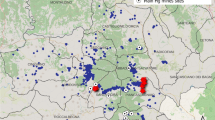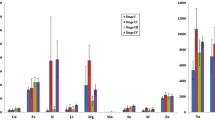Abstract
The infection caused by Helicobacter pylori (H. pylori) disrupts the metabolism and absorption of essential trace elements. Stomach disorders are related to changes in essential trace element metabolism caused by increased toxic metal exposure and H. pylori infection. The aim of the work is to link the development of stomach-related illnesses to an imbalance of essential trace and toxic metals. We have investigated the variations in essential trace elements such zinc (Zn), iron (Fe), and copper and toxic metals like lead (Pb) and cadmium (Cd) in biological (scalp hair, blood) samples of glass and cement workers. The study participants are further divided into smokers and nonsmokers, as well as diseased (gastric ulcer, irritable bowel syndrome, and chronic ulcer) and exposed referents (non-diseased industrial workers). Biological samples of age-matched (40–60 years) male subjects living in non-industrial areas were gathered for comparative purposes. After a pre-concentration method, the drinking water of industrial and domestic areas was analysed for both toxic metals. Microwave-aided acid digestion was used to oxidise the matrices of biological samples before atomic absorption spectrometer analysis of selected metals. Toxic metal levels in both industries’ drinking water were much higher than those found in domestically treated water (p < 0.01). Industrial workers suffering different types of stomach disorders have two to three times higher Pb and Cd concentrations than age-matched referents. Toxic metals are found in higher concentrations in smoker referents and diseased patients’ biological samples than in nonsmoker subjects. The findings of this study suggested that Pb and Cd toxicity’s immunological effects may be associated to an increased vulnerability to chronic infections.
Similar content being viewed by others
Data Availability
The datasets generated and/or analysed during the current study are available from the corresponding author on reasonable request.
Code Availability
Not applicable.
References
Plummer M, Franceschi S, Vignat J, Forman D, de Martel C (2015) Global burden of gastric cancer attributable to Helicobacter pylori. Int J Cancer 136(2):487–490
Akcam M (2010) Helicobacter pylori and micronutrients. Indian Pediatr 47:119–126
Ozturk N, Kurt N, Ozgeris FB, Baygutalp NK, Tosun MS, Bakan N, Bakan E (2015) Serum zinc, copper, magnesium and selenium levels in children with Helicobacter pylori infection. Eurasian J Med 47:126–129
McColl KE, El-Omar E, Gillen D (2000) Helicobacter pylori gastritis and gastric physiology. Gastroenterol Clin North Am 29:687–703
El-Omar EM (2006) (2006) Mechanisms of increased acid secretion after eradication of Helicobacter pylori infection. Gut 55:144–146
Wintergerst ES, Maggini S, Hornig DH (2007) Contribution of selected vitamins and trace elements to immune function. Ann Nutr Metab 51:301–323
Prá D, Franke SIR, Henriques JAP, Michael Fenech Pra D, Rech Franke SI, Pegas Henriques JA, Fenech M (2009) A possible link between iron deficiency and gastrointestinal carcinogenesis. Nutr Cancer 61(4):415–426
Baysoy G, Ertem D, Ademoglu E, Kotiloglu E, Keskin S, Pehlivanoglu E (2004) Gastric histopathology, iron status and iron deficiency anemia in children with Helicobacter pylori infection. J Pediatr Gastroenterol Nutr 38:146–151
Salgueiro J, Zubillaga M, Goldman C, Barrado A, Sarrasague MM, Leonardi N, Boccio J (2004) Review article: is there a link between micronutrient malnutrition and Helicobacter pylori infection? Aliment Pharmacol Ther 20:1029–1034
Annibale B, Capurso G (2001) Delle Fave G (2001) Consequences of Helicobacter pylori infection on the absorption of micronutrients. Dig Liver Dis 34(Suppl. 2):S72–S77
Tapiero H, Tew KD (2003) Trace elements in human physiology and pathology: zinc and metallothioneins. Biomed Pharmacother 57:399–411
Santos LH, Feres CA, Melo FH, Coelho MM, Nothenberg MS, Oga S et al (2004) Anti-inflammatory, antinociceptive and ulcerogenic activity of a zinc diclofenac complex in rats. Braz J Med Biol Res 37:1205–1213
Bandyopadhyay B, Bandyopadhyay SK (1997) Protective effect of zinc gluconate on chemically induced gastric ulcer. Indian J Med Res 106:27–32
Bandyopadhyay B, Banerjee P, Bhattacharya B, Bandyopadhyay SK (1995) Serum zinc level: a possible index in the pathogenesis of peptic ulcer syndrome. Biochem Mol Biol Int 36(5):965–972
Shike M (2009) Copper in parenteral nutrition Gastroenterol 137:S13–S17
Vitale G, Barbaro F, Ianiro G et al (2011) Nutritional aspects of Helicobacter pylori infection. Minerva Gastroenterol Dietol 57:369–377
Yuan W, Yang N, Li X (2016) Advances in understanding how heavy metal pollution triggers gastric cancer. Biomed Res Int 2016:7825432–7825410
Soylak M, Uzun A, Elci L (2001) Chemical analysis of industrial waste water samples from some metal and textile plants in the organized industrial region of Kayseri-Turkey. Kuwait J Sci Eng 28:151–160
Khan N, Afridi HI, Kazi TG, Akhtar A, Khan M (2017) Correlation of cadmium and magnesium in the blood and serum samples of smokers and non-smokers chronic leukemia patients. Biol Trace Elem Res 176:81–88
Kazi TG, Wadhwa SK, Afridi HI, Talpur FN,, Siddiqui AA (2016) Evaluate the levels of essential and toxic elements in blood samples of smoker males have different types of cancers with related to healthy subjects. J Clin Med Res Update 3: 8–16 https://doi.org/10.15379/2413-7324.2016.03.03
WHO (1997) Tobacco or Health: a global status report. Ginebra: WHO 19.
Bilal M, Kazi TG, Afridi HI, Arain MB, Baig JA, Khan M (2016) Application of conventional and modified cloud point extraction for simultaneous enrichment of cadmium, lead and copper in lake water. J Ind Eng Chem 40:137–144
World Health Organization 2011Guidelines for drinking-water quality Geneva, Switzerland
Reddy D, Gunasekar A (2013) Chronic kidney disease in two coastal districts of Andhra Pradesh, India: role of drinking water. Environ Geochem Health 35:439–454
Panhwar AH, Kazi TG, Afridi HI, Arain SA, Arain MS, Brahaman KD, Naeemullah ASS (2016) Correlation of cadmium and aluminum in blood samples of kidney disorder patients with drinking water and tobacco smoking: related health risk. Environ Geochem Health 38(1):265–274
Roels HA, Hoet P, Lison D (1999) Usefulness of biomarkers of exposure to inorganic mercury, lead, or cadmium in controlling occupational and environmental risks of nephrotoxicity. Ren Fail 21:251–262
Stefanidou M, Maravelias C, Dona A (2006) Spiliopoulou C (2006) Zinc: a multipurpose trace element. Arch Toxicol 80:1–9
Sanchez LC (2018) Disorders of the gastrointestinal system. Equine Internal Medicine 5:709–842
Prasad AS (2013) Discovery of human zinc deficiency: its impact on human health and disease. Adv Nutr 4(2):176–190
Yu Q, Sun X, Zhao J et al (2019) The effects of zinc deficiency on homeostasis of twelve minerals and trace elements in the serum, feces, urine and liver of rats. Nutr Metab 16:73–80
Yazdanpanah K, Moghimi N, Yousefinejad V, Ghaderi E, Darvishi N (2009) Effect of zinc sulphate on peptic ulcer disease. Pak J Med Sci 25(3):404–407
Janjetic MA, Goldman CG, Balcarce NE, Rua EC, Gonzalez AB, Fuda JA, Meseri EI, Torti HE, Barrado J, ZubillagaMB LLB, Boccio JR (2010) Iron, zinc, and copper nutritional status in children infected with Helicobacter pylori. J Pediatr Gastroenterol Nutr 51(1):85–89. https://doi.org/10.1097/MPG.0b013e3181c2c2cd
Ozturk N, Kurt N, Ozgeris FB, Baygutalp NK, Tosun MS, Bakan N, Bakan E (2015) Serum zinc, copper, magnesium and selenium levels in children with helicobacter pylori infection. Eurasian J Med 47(2):126–129. https://doi.org/10.5152/eurasianjmed.2015.104
Zhang AS, Enns CA (2009) Molecular mechanisms of normal iron homeostasis. Hematology Am Soc Hematol Educ Program 207–14.
Johnson-Wimbley TD, Graham DY (2011) Diagnosis and management of iron deficiency anemia in the 21st century. Ther Adv Gastroenterol 4:177–184
Pra D, Rech Franke SI, Pegas Henriques JA, Fenech M (2009) A possible link between iron deficiency and gastrointestinal carcinogenesis. Nutr Cancer 61(4):415–426. https://doi.org/10.1080/01635580902803701
Monzon H, Forne M, Esteve M, Rosinach M, Loras C, Espinos JC et al (2013) Helicobacter pylori infection as a cause of iron deficiency anaemia of unknown origin. World J Gastroenterol 19(26):4166–4171
Bertin G, Averbeck D (2006) Cadmium: cellular effects, modifications of biomolecules, modulation of DNA repair and genotoxic consequences (a review). Biochimie 88(11):1549–1559
Bulat ZP, Dukic -Cosic D, Đokic M, Bulat P, Matovic V, (2009) Blood and urine cadmium and bioelements profile in nickel -cadmium battery workers in Serbia. ToxicolInd Health 25(2):129–135
Stohs SJ, Bagchi D (1995) Oxidative mechanisms in the toxicity of metal ions. Free Radic Biol Med 18:321–336
Levitt DG, Levitt MD (2016) Human serum albumin homeostasis: a new look at the roles of synthesis, catabolism, renal and gastrointestinal excretion, and the clinical value of serum albumin measurements. Int J Gen Med 9:229–255
Khlifi R, Hamza-Chaffai A (2010) Head and neck cancer due to heavy metal exposure via tobacco smoking and professional exposure: a review. Toxicol Appl Pharmacol 248:71–88
Allais L, Kerckhof FM, Verschuere S, Bracke KR, De Smet R, Laukens D et al (2016) Chronic cigarette smoke exposure induces microbial and inflammatory shifts and mucin changes in the murine gut. Environ Microbiol 18(5):1352–1363
Lindell G, Farnebo LO, Chen D, Nexø E, Rask Madsen J, Bukhave K et al (1993) Acute effects of smoking during modified sham feeding in duodenal ulcer patients. An analysis of nicotine, acid secretion, gastrin, catecholamines, epidermal growth factor, prostaglandin E2, and bile acids. Scand J Gastroenterol 28:487–494
Ogihara A, Kikuchi S, Hasegawa A, Kurosawa M, Miki K, Kaneko E et al (2000) Relationship between Helicobacter pylori infection and smoking and drinking habits. J Gastroenterol Hepatol 15:271–276
Acknowledgements
We thank the National Centre of Excellence in Analytical Chemistry, University of Sindh, in providing well-equipped laboratories for research work.
Author information
Authors and Affiliations
Contributions
Dr. Hassan Imran Afridi (Ph.D) and Prof. Dr. Tasneen Gul Kazi (Ph.D) made project and took part in designing the study, clinical diagnosis, and selecting patients, made file of each selected subjects, and in addition took part in writing the manuscript. Miss Sadaf Parveen (M.Phil), Ghulam Qadir Chanihoon (M.Phil), Ahsan Ali Memon (M.Phil), and Almas Rahoojo (M.Phil) participated in biological sample collection and analysis through atomic absorption spectrophotometer. Dr. Farah Naz Talpur (Ph.D) and Dr. Jameel Ahmed Baig (Ph.D) took part in statistically calculating the data as well as proof reading and correction of language.
Corresponding author
Ethics declarations
Consent to Participate
Before collecting the biological samples from patients and referents, written and verbal consent was done.
Consent for Publication
Not applicable.
Conflict of Interest
The authors declare no competing interests.
Additional information
Publisher's Note
Springer Nature remains neutral with regard to jurisdictional claims in published maps and institutional affiliations.
Rights and permissions
About this article
Cite this article
Parveen, S., Imran Afridi, H., Gul Kazi, T. et al. Impacts of Smoking and Stomach Disorders on Essential Elements in Biological Samples of Cement and Glass Industrial Workers. Biol Trace Elem Res 201, 1065–1079 (2023). https://doi.org/10.1007/s12011-022-03238-y
Received:
Accepted:
Published:
Issue Date:
DOI: https://doi.org/10.1007/s12011-022-03238-y




